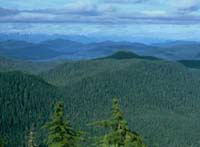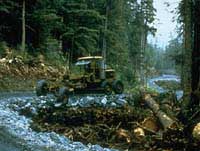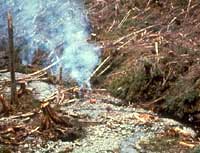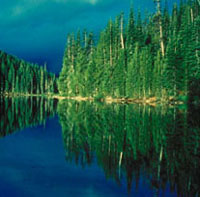Matt Zencey is campaign manager of the Alaska Rainforest Campaign. A 19-year resident of Anchorage, Alaska, Matt temporarily moved to Washington, D.C., last fall to expand the campaign’s national operation. He will be glad to leave behind the chaos and congestion of the Washington area in June, when he will return to the campaign’s Alaska office.
Monday, 1 May 2000
WASHINGTON, D.C.
Every day I come into the office with one thing uppermost in my mind. What can our campaign do, between now and noon on January 20, 2001, to persuade President Clinton that his pending national forest protection policy — his major claim to an environmental legacy — has to include Alaska’s Tongass National Forest?

Arial view of the Alaska rainforest.
Photo: Alaska Rainforest Campaign.
The Tongass is the heart of Alaska’s rainforest, which is the biggest remaining temperate rainforest in the world. The Tongass is our largest and wildest national forest, but it is being chewed up by a logging program that loses more taxpayer money than any other in the national forest system. Because the timber industry has a powerful friend in Alaska’s Sen. Ted Stevens (R), chair of the Senate committee that controls all spending decisions, the Tongass is the only forest at risk of being excluded from the president’s progressive, precedent-setting forest protection policy.
Today, there is good news, compliments of our fellow forest activists who have been promoting this initiative. On page A-5 of the Washington Post, there is a three-quarter-page ad, with the headline, “3 Out of 4 Agree Protect What’s Left of Our National Forests.” The ad, sponsored by the Heritage Forests Campaign, goes on to say, “according to a recent national poll, more than 75 percent of Americans support an historic initiative which would conserve forever the last remaining roadless areas in our national forests.”
A TV ad on the same theme is also running on the morning news shows here in Washington, D.C. Heritage Forests has done a great job getting the president to embrace this initiative and make it part of his environmental legacy. These ads will help deflect some of the torrential criticism launched by Western Republicans in Congress, who have gone ballistic over the president’s proposal, as they do over any move to better protect our nation’s public lands. With Heritage Forests promoting the overall policy, our job is to make sure the president’s initiative will, in the end, cover Alaska’s Tongass.

Should this be the end of the road?
Photo: Alaska Rainforest Campaign.
More than any other forest, the Tongass needs the president’s help. Two million acres of wildlands in the Tongass — an area bigger than Delaware and Rhode Island put together — are still open to exploitation, including more than 400,000 acres of lush old-growth spruce, hemlock, and cedar that have been around for centuries. The Tongass is the one national forest that hasn’t been completely trashed by decades of logging, so there is still plenty there to save. And yet, some 70 percent of all future logging in the Tongass is scheduled for remote backcountry wildlands. Building timber roads into these frontier wilderness areas is incredibly expensive, which is why the Tongass timber program is the worst money loser in the entire Forest Service system.
How can we get the president’s attention and let him know that his environmental legacy is in jeopardy if his forest protection plan leaves out the Tongass? We’re just a small school of fish in a big sea of issues that compete for the president’s time.
We’ve already produced roughly 250,000 comments to the Forest Service, insisting that the Tongass be included in the president’s policy. (The Forest Service is doing the environmental impact statement required to translate the president’s protection proposal into binding federal rules that will guide future forest management.) We’re on track to get twice as many comments — half a million, at least — for the next stage of the official agency rule-making process.
A slew of editorials urging the president to include the Tongass in his historic forest policy have appeared in major newspapers — the New York Times, the Los Angeles Times, the Boston Globe, the Houston Chronicle, both San Francisco papers, the Detroit Free Press, the Seattle Times, and two dozen others. As the New York Times wrote, “The plan’s most glaring flaw is that it does not include the Tongass National Forest.” The Seattle Times got it just right: “Adding the Tongass would be a crowning touch to a plan with grand generational sweep.”
So, Mr. President. We hope you are listening.
Tomorrow: What’s ahead in the next eight months.
Tuesday, 2 May 2000
WASHINGTON, D.C.
Yesterday was a perfect spring day here in Washington, D.C. Riding my bike to the Silver Spring Metro station, I thought that such a day is almost enough to seduce a person into thinking this place could be habitable on a permanent basis. But having grown up in Delaware, I know the brutal humid summer that awaits. I and my wife and our two boys eagerly await our return to Alaska in June, when my tour of duty here in D.C. will be over and I go back to running the campaign from our Anchorage office.
I’ve learned a lot about how things work in Washington, which was part of the reason I volunteered to come here for a year with my family.

Would you trade virgin rainforest for this?
Photo: Alaska Rainforest Campaign.
For starters, I’ve learned that you have to watch out for how your issue gets caught up in the horse-trading — that is, the stock-and-trade of politics. Just one example: Alaska’s rabidly pro-timber Sen. Frank Murkowski (R) is trying to raid 4,200 acres of old-growth from the Tongass National Forest so his timber industry buddies can grab it. The only reason he’s got a prayer of pulling off this raid is that he is arm-twisting some Democratic senators who want things out of the Senate Energy Committee that he chairs. To keep the Clinton administration from vetoing or stopping his Tongass raid, Murkowski is planning to throw a chunk of money to the Forest Service so the agency can buy private inholdings in the Tongass. That wouldn’t be such a bad idea, except for one thing — the lands to be bought have already been blitzed in an orgy of clear-cutting. Murkowski’s Tongass raid trades old-growth for stumps — what a deal! It’s not a fait accompli yet, but it’s a difficult fight because folks who normally support our concerns have their own deals going with Murkowski.
I’ve also had an up-close-and-personal look at the extent to which money rules the day inside the Beltway. A friend of mine knows some media consultants and arranged for me to meet with them and talk shop. It was depressing to hear how much money it takes to get your media message out in a credible way. Life would be so much easier if we only had $5 or $10 million to burn on TV spots. But neither I nor any enviros I know move in such rarified financial circles.

A bear at home in the Tongass.
Photo: Alaska Rainforest Campaign.
I’ve been to two fund
raisers: One was a $50-a-head affair, where I was able to chat up a friendly congressman and his chief of staff. At the other, I was a non-paying guest at a $1,000-a-head bash, thanks to a friendly connection, and got a chance to briefly speak with a senator. Both times I felt about as comfortable as an atheist at high Catholic mass.
Washington, D.C., is okay, as an anthropological experience. It’s useful to learn the strange folkways of the powerful tribes that inhabit this corner of the world and make decisions that shape the future of Alaska’s rainforest. And compared to the retrograde anti-conservationist forces that control Alaska’s state legislature, Congress is a bastion of environmental enlightenment. But I know that I am not and never will be a Washington insider. We need the insiders to make the right decisions for Alaska’s Tongass, but to accomplish that, we have to do most of our work from the outside looking in.
Wednesday, 3 May 2000
WASHINGTON, D.C.
Yesterday I wrote about how playing the Washington, D.C., political game was a necessary but not appealing part of my job. Funny, then, that I should get invited to a fancy reception last night for former Sen. Dale Bumpers (D-Ark.), now starting a new career as a lobbyist for Arent Fox Kintner Plotkin & Kahn, PLLC.
Bumpers is a hot commodity in Washington, after his stirring defense of President Clinton during the impeachment crisis helped keep Clinton in office. D.C. insiders figure that a grateful Clinton will be more than happy to listen to what Bumpers has to say.
During his years in the Senate, Bumpers was a great advocate for Alaska conservation causes and fought many a battle to help protect Alaska’s Tongass National Forest.
My usual work attire is jeans and a dress shirt, so I keep a jacket, tie, and nice slacks in the closet. Shortly after 6 p.m., I “put on the uniform” and headed over to La Colline, an upscale restaurant just north of the Capitol.
I’m not a very social animal, and I had never met any of the folks who would be there, so I was looking forward to this as much as a trip to the dentist. I forced myself to be sociable, chatting up some of the junior members of the firm until Bumpers was introduced to the gathering. After Bumpers spoke, I figured there would be a crush afterward to meet and greet him, but I headed over there anyway.
En route, I saw former Sen. Howard Metzenbaum (D-Ohio), who was a great champion of Alaska conservation issues during his time in the Senate. There was a brief opening with him, so I gave him a 10-second thank you for his work. Metzenbaum looks a little frail and has a hearing aid. As I began talking, he leaned his ear closer to me. I don’t know how much he heard. He just smiled a big smile and said “thanks” as I moved on toward Bumpers.
Much to my surprise, there were only a couple of people around him. I loitered, smiling, directly across from him and waited for a pause in the conversation.
“Senator,” I said, sticking out my hand, “I’m Matt Zencey, with the Alaska Rainforest Campaign.” He grabbed my hand and shook it firmly the entire time I delivered my rap. “We work on the Tongass National Forest in Alaska. During your time in the Senate, you were a great champion for the Tongass. I just wanted to say thanks for all your good work.”
He just smiled and said, “Thanks,” and away I went. I set down my wine glass and practically bolted for the door.
On the way out, I saw New Mexico Sen. Jeff Bingaman (D) coming in. As the ranking Democrat on the Senate Energy Committee, he does battle on Alaska conservation issues with the chair of the committee, Alaska’s boisterously pro-development Sen. Frank Murkowski (R). It didn’t seem like the right time to buttonhole Sen. Bingaman so I just headed off to Union Station.
“Enough of this,” I thought. “I’m ready to get home. I want to see my kids.”
Thursday, 4 May 2000
WASHINGTON, D.C.
Craziness rules the day here. We’ve got a major media “hook” coming for our top-priority issue. We’re scrambling to get information out to reporters and editorial writers. It’s a high-stress time anyway, made worse by rampant, multiple, infuriating technological snafus — and by having to squeeze in time to write the Grist diary every morning. What was I thinking when I agreed to write this @#%&* diary??? Grrrr …
Yesterday, our email crashed just after I finished writing the day’s diary, but before I could file it. It took about an hour to file it from another computer, but not before I had to exterminate a virus in my floppy drive, find disks that the floppy drive would deign to read (they weren’t full but the drive thought they were), and get the file to another computer that had a working email connection.

Is trouble brewing for the Tongass?
Photo: Alaska Rainforest Campaign.
After the diary work, I switched over to work on our media mailing. The Forest Service will soon release its version of President Clinton’s national forest protection policy for roadless areas. It is likely to be a watered-down version that leaves out Alaska’s Tongass National Forest — our baby! We’ve been calling and faxing and mailing to give media folks the heads-up on what’s coming.
Doing the mailing required us to look up addresses on our media database, which is housed on our website, which we couldn’t access because of the aforementioned technological glitches. We tried looking up the addresses on our CD copy of the Bacon’s media guide. However, Bacon’s is the antithesis of user-friendly software. It’s about as intuitive as Mandarin Chinese. Neither I nor my new media person, Ron Olsen, could figure it out. Our resident expert on Bacon’s was out of the office for another two days. We finally borrowed a hard copy from another group, which required a quick bike ride across town by Katja Dillmann, our conservation assistant.
We spent the rest of the afternoon hand-addressing envelopes to a hodge-podge list of media contacts. Some are from our lists, some from other friendly media types, some from Bacon’s. This is not the way things are supposed to work. We’re supposed to have a state-of-the-art media database available from our website, which enables us to instantly fax our info directly to each media name on the list, but our tech consultants have been bogged down on the project for weeks. Grrrr …
We finally finished at 7 p.m. Wednesday and dashed off to the post office.
This morning, it’s time to for me to send follow-up faxes to all the reporters I called yesterday. I want to copy the info onto letterhead before faxing, but our copier (a lame prehistoric model) is producing washed out copies, so I have to run around the corner to the Sierra Club office to use their machine.
When I come back, our fax machine is flatlining — it’s totally unresponsive to any command (even though it’s plugged in and lit up), staring back at me like a zombie. Several minutes of tinkering and it stirs to life — and sends one fax before fritzing again with a different ailment. Ned Ludd was right! Down with technology!! If I had a sledgehammer, some office equipment here would be in real trouble.
If I weren’t diary writing right now, I’d be on a conference call to strategize how the enviro community will respond when the Forest Service releases it’s version of the president’s forest protection policy. I have to skip it, but I’m due to hop in a cab as soon as I’m done here and catch a meeting of enviro group media folks who are working up the message for the Forest Service announcement. Just my luck, I’ll get stuck in traffic and be horribly late.
Here’s hoping tomorrow is less insane …
Friday, 5 May 2000
WASHINGTON, D.C.
The technological snafus I ranted about in yesterday’s entry look trivial compared to the havoc wrought by the “ILOVEYOU” virus (or worm or whatever they call it), which shut down Internet connections and erased data on computers worldwide. Here at rainforest battle central, we got no LOVE, so we got no virus. I’m sure glad we dodged that bullet.
Our office — balky equipment, cramped quarters — has me wishing that our search for new office space were going faster. We are located in “Alaska House,” an aging townhouse on Capitol Hill that we share with one of our coalition partners, Alaska Wilderness League.
Alaska House has a storied history and a kind of low-rent charm. It is a base camp where visiting Alaska conservation activists set up shop when they come to D.C. There are a couple of extra desks and phone lines for them to use and a wealth of inside information at their disposal from the Alaska Wilderness League folks. When an Alaska issue is running hot here in Washington, the House is jammed to the gills with people phoning and faxing and Xeroxing and getting ready to dash off for meetings with decision-makers. It can be about as chaotic as a fire hall mobilizing to fight a four-alarm blaze. There’s great energy and camaraderie here, a real sense of mission, and great people who know how to get things done. They work hard and they play hard.
There’s a downside, though. What on a good day seems like cozy, collegial quarters can feel, on a hectic, humid summer day, like working in a submarine that’s running out of fresh air. We need more space! We need a copier that works! We need high-speed Internet connections! We need more phone lines! All must wait until we can find that elusive commodity on Capitol Hill — affordable, convenient office space.
Good news today from Taxpayers for Common Sense, an organization that fights environmentally harmful government subsidies and projects. They report that “The Fleecing of America” feature on NBC’s national news will air a story on one of the battles we are fighting, the University of Alaska land grab. It might hit the air tonight.
This is an issue where Alaska Sen. Frank Murkowski (R) is using the financial woes of Alaska’s state university as an excuse to launch a raid on federal public lands in Alaska. Murkowski says the university never got all the land it was entitled to under the federal system of land grants for higher education. He’s pushing a bill that would let the university grab up to 500,000 acres (two and a half times the area of Shenandoah National Park, here in Washington, D.C.’s backyard). The university could take the land from places like the Chugach National Forest, the National Petroleum Reserve Alaska, the Outer Continental Shelf (site of potentially valuable oil leases), and second-growth lands in the Tongass National Forest.
Once the university gets its hands on the lands, it would be duty bound to develop them for maximum financial benefit. On timber lands, that would mean wanton clear-cutting. One university logging site, near Ketchikan, is known as “Slide Ridge” because the timber was cut from such a steep slope that the loggers had to rappel by rope down from the top to cut the trees. The state Division of Forestry just shut down university logging operations at another site because erosion was fouling nearby fish streams. It must have been pretty bad, because the state is one sleepy, small town sheriff when it comes to watchdogging timber operators. The university could also grab some pretty attractive recreational sites in the rainforest and sell them as vacation properties or install big lodges to serve Alaska’s ever-growing stream of cruise ship visitors.
Murkowski’s bill is an environmentally ruinous giveaway — and a completely unnecessary one at that. Alaska has plenty of land and money to take care of its needs, including the university. When Alaska entered the Union in 1959, the federal government gave it the right to select 102.5 million acres — an area equal to the state of California — to be used as the state saw fit. The state picked North Slope lands that included Prudhoe Bay, which became the nation’s largest oil field. After 23 years of oil production, the state has some $27 billion stashed in a savings account called the Permanent Fund.
Earnings from the fund can be used on any state government function. But what do Alaska politicians do with the money? Do they spend it on the struggling state university, which Murkowski says he is so eager to help? No. Alaska politicians sprinkle the landscape with cash handouts to every resident. Last year, every bona fide resident — man, woman and child — got a check for $1,767. That’s $7,068 for a family of four. The total cost of the handouts was $1 BILLION. That’s B for billion.
Seen in this light, the answer to the university’s financial woes is state cash, not federal land. Murkowski’s bill is just a cynical ploy to pry lands out of protected federal status and open them up to more rapid development. It is, as NBC has apparently discovered, a gross example of the Fleecing of America.

